#USS SARATOGA (CV-3)
Explore tagged Tumblr posts
Text

Porte-avions USS Saratoga (CV-3) en cale sèche – 1928
©United States Navy National Museum of Naval Aviation - 1989.119.002
#WWII#ww2#avant-guerre#pre war#marine américaine#us navy#marine militaire#military navy#porte-avions#arircraft carrier#classe lexington#lexington-class#uss saratoga (cv-3)#uss saratoga#cv-3#1928
27 notes
·
View notes
Text

USS SARATOGA (CV-3) at Ford Island, Pearl Harbor Navy Yard, Hawaii. SARATOGA's refit at Puget Sound Navy Yard was completed on January 2, 1944 and she arrived at Pearl Harbor on January 7. "The ship, now the flagship of Rear Admiral Samuel Ginder, commander of Task Group 58.4, sailed from Pearl Harbor on January 19 with USS LANGLEY (CVL-27) and USS PRINCETON (CVL-23), to support the invasion of the Marshall Islands scheduled to begin on February 1. Her air group at this time consisted of 36 Hellcats of VF-12, 24 Dauntlesses of VB-12 and eight Avengers of VT-8."
-Information from Wikipedia: link
Photographed sometime between January 7 and 19, 1944.
Digital Archives of Hawai'i: PPFUR-1-21-007
#USS Saratoga (CV-3)#USS Saratoga#Lexington Class#Aircraft Carrier#warship#ship#January#1944#World War II#World War 2#WWII#WW2#WWII History#History#Pearl Harbor Navy Yard#Pearl Harbor#Hawaii#united states navy#us navy#navy#usn#u.s. navy#my post
10 notes
·
View notes
Text

The U.S. Navy aircraft carrier USS Saratoga (CV-3), circa 1942. Planes on deck include five Grumman F4F-4 Wildcat fighters, six Douglas SBD-3 Dauntless dive bombers and one Grumman TBF-1 Avenger torpedo plane.
13 notes
·
View notes
Text

Martin BM-2 bomber of VT-2B of USS Saratoga (CV-3) in Oakland, California, sometime between 1931 and 1934.
16 notes
·
View notes
Text

October 1943
Deck crew spot-checking Douglas SBD-5 Dauntless dive bombers of bombing squadron VB-12 on the flight deck of the U.S. Navy aircraft carrier USS Saratoga (CV-3)
OPERATION SHOESTRING 2
After participating in combined fleet exercises off Espiritu Santo between the 7th and 10th of October 1943, VF-12, now part of
Carrier Air Group 12, departed Espiritu Santo aboard the USS Saratoga (CV-3) on October 31,1943; along with Air Group
23 aboard the USS Princeton (CVL-23), to form backbone of TaskForce 38. Here USS Saratoga is underway off Espiritu Santo in October 1943.
As part of Operation Shoestring 2, Task Force 38 was assigned to raid the Japanese airfields on Buka and Bonis Islands off the northern tip of Bougainville, in order to cover the landings being made at Cape Torokina and Empress Augusta Bay. For the first two days in November 1943, the Saratoga, and Princeton made
vicious assaults on the Buka and Bonis Islands airfields, approaching so close to shore (13 miles south east of the islands (06* 25’ S 154* 53’ E) that the twin fields were almost visible from the ships. (vbf-12.com)
(U.S. Navy Photograph, U.S. National Archives and Records Administration)
(Colourised by Benjamin Thomas)
74 notes
·
View notes
Text

Douglas SBD-5 Dauntless of squadron VB-12. USS Saratoga (CV-3), October 1943
55 notes
·
View notes
Text

Douglas SBD-5 Dauntless of squadron VB-12. USS Saratoga (CV-3), October 1943 ➤ THE PACIFIC WAR [DOC]: https://youtu.be/hdAz_qjBT78 ➤HD IMAGE: https://dronescapes.video/Dauntless
#wwii airplane#world war ii#ww2#naval#world war two#world war 2#wwiii#wwii history#wwii era#wwii#aviation history#military#documentary#dronescapes#aviation#airplane#aircraft#youtube#uss saratoga#aircraft carrier#us navy#SBD-5#Dautless#colorized#WWII History in color#military history#world history#history#histoire
63 notes
·
View notes
Text

A BM-2 from VT-2B assigned to USS Saratoga (CV-3) at Oakland Airport, California, early 1930s
46 notes
·
View notes
Text

A U.S. Navy Douglas SBD-3 Dauntless flies over the aircraft carriers USS Enterprise (CV-6), foreground, and USS Saratoga (CV-3) near Guadalcanal on 19 December 1942. The aircraft is likely on anti-submarine patrol. Saratoga is trailed by her plane guard destroyer. Another flight of three aircraft is visible near the Saratoga. The radar array on the Enterprise has been obscured by a wartime censor.
Both carriers had been badly damaged off Guadalcanal the previous August but had been patched up at Pearl Harbor and sent back on duty as the only USN fleet carriers left in the Pacific.
87 notes
·
View notes
Text
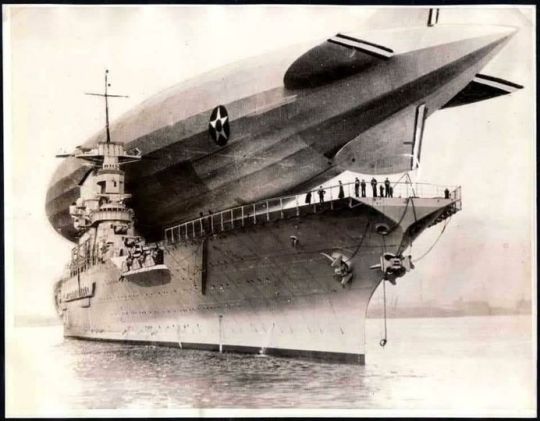
Airship USS Los Angeles
Airship USS Los Angeles (ZR-3) after landing on board the carrier USS Saratoga (CV-3) - 28 January 1928 - Saratoga was the longest warship in the world from her launch in 1925 until the launch of the USS Midway in 1945.
205 notes
·
View notes
Text
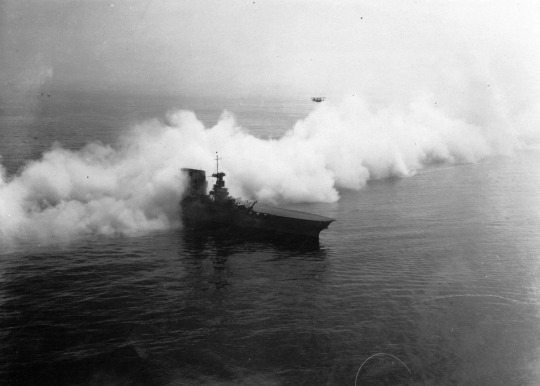
Le porte-avions USS Saratoga (CV-3) pendant les manœuvres de la flotte américaine au large de San Diego – Californie – Etats-Unis – 1930's
©Naval History and Heritage Command - NH 94859
#avant-guerre#pre-war#marine américaine#us navy#marine militaire#military navy#marine de guerre#navy#porte-avions#aircraft carrier#classe lexington#lexington-class#uss saratoga (cv-3)#uss saratoga#cv-3#san diego#californie#california#états-unis#usa#1930's
13 notes
·
View notes
Text

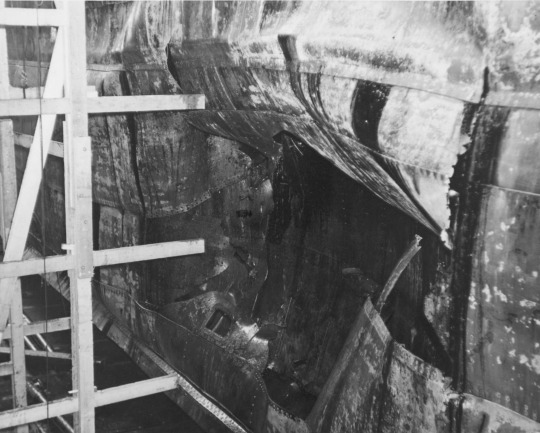
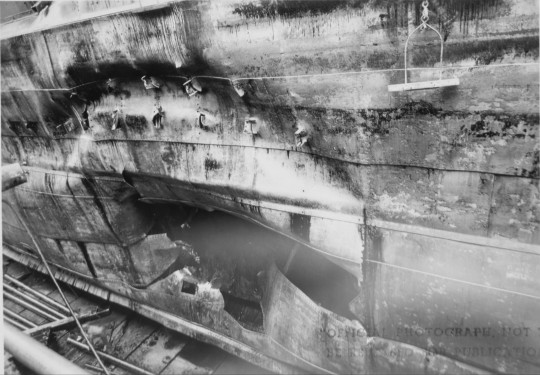
View of torpedo damage to USS SARATOGA (CV-3), while in dry dock at Pearl Harbor. Her hull was given a temporary patch for her trip to Puget Sound Navy Yard for permanent repairs.
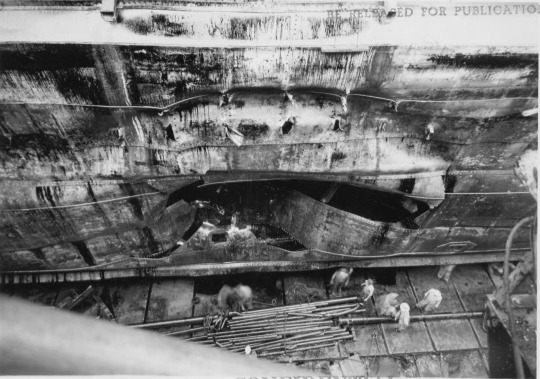
SARATOGA was about 420 nautical miles (780 km; 480 mi) southwest of Pearl Harbor, when she was hit by a torpedo fired by I-6. The explosion flooded three boiler rooms and killed 6 crewmen. Her crew was able to close off those areas and reduce the ship's list. Her speed was reduced to 16 knots and she returned to Pearl Harbor two days later.



Note how the bottom plating below the bilge keel was forced out by the explosion


Diagrams of the damaged areas from the Damage Report: link
Admiral Furlong Collection
Date: January 16, 1942
Digital Archives of Hawai'i: PPFUR-3-13-006, PPFUR-3-13-001, PPFUR-3-13-008, PPFUR-3-13-007, PPFUR-3-13-004, PPFUR-3-13-003, PPFUR-3-13-002
#USS SARATOGA (CV-3)#USS SARATOGA#Lexington Class#Aircraft Carrier#Carrier#Warship#Ship#United States Navy#U.S. Navy#US Navy#USN#Navy#dry dock#drydock#World War II#World War 2#WWII#WW2#WWII History#History#Military History#Puget Sound Navy Yard#Puget Sound#Washington#West Coast#January#1942#my post
34 notes
·
View notes
Text
I have bad memory and I know posted this question once but I CANT FIND IT. So uh, would america blow up it's own ships after retirement? Because anyway the vehicles on land barely give a shit according to my hcs about ships.
Like this question is mainly because I'm woc-fying USS Saratoga (CV-3) and USS America (CV-66) and both of them were used in experiments. Saratoga was used in a nuclear bomb test and Bikini atoll and America was bombarded in a live firing test and was blown by explosives. LIKE HOW INHUMANE IS THAT ESP FOR THOSE WHO SERVED UR NATION? And no way in hell would Kittyhawk class carrier allow the navy to even use America in such a way.
Been thinking like Kittyhawk and others absolutely refused to allow that to happen to America cause like, imagine being alive and killed BY YOUR OWN NAVY? Conscience will haunt them, and THAT'S THEIR SISTER SHIP RIGHT THERE. She was scuttled btw, so what if they just tested on her for awhile and then let her before too serious to be alive injuries?? Idk help
12 notes
·
View notes
Text

5 November 1943:
US Navy pilots, (in front) Lieutenant (jg) Henry H. Dearing of Cleveland, Ohio, Ensign Charles W. Miller of Houston, Texas and Lieutenant (jg) Bus Alder of San Mateo, California walking toward their Grumman F6F-3 'Hellcats' aboard the aircraft carrier USS Saratoga (CV-3).
These men provided fighter coverage for Avenger torpedo bombers and Dauntless dive bombers. On November 5th 1943, in response to reports of Japanese cruisers concentrating at Rabaul, Papua New Guinea, the Saratoga aircraft penetrated the heavily defended port and disabled most of the Japanese cruisers, ending the surface threat to Bougainville. Saratoga herself escaped unscathed.
(Photo by Lt. Wayne Miller of the U.S. Navy Combat Photo Unit)
(Colourised by Doug)
1 note
·
View note
Text

VF-103 F-14 crew member tells the story of TARPS IR photo of Egypt Air Boeing 737 carrying Achille Lauro hijackers after landing at Sigonella
F-14 Tomcat TARPS equipped
The F-14 equipped with Tactical Airborne Reconnaissance Pod System (TARPS) … or Peeping Tom.
According to Home of M.A.T.S., until introduction of a replacement on the F/A-18, the TARPS was the only possibility for the Navy to get tactical information about an area or target via a fast flying aircraft, the F-14. Since the retirement of the RF-8, the RF-4B and various A-3 Skywarrior variants, the F-14 was the only aircraft for this role (and can carry at the same time a complete range of air-to-air weapons!) until the introduction of a F/A-18 recce aircraft with reconnaissance equipment instead of a gun!
Taken in 1985 by a TARPS equipped VF-103 Sluggers F-14 Tomcat the IR photo featured in this article shows the Egypt Air Boeing 737 carrying the Achille Lauro hijackers after landing at Sigonella.
During CVW-17’s August 1985-1986 Med deployment, CVW-17’s aircraft were responsible for the successful intercept and forced landing of the Egyptian airliner carrying the infamous Achille Lauro ship hijackers.
More details on the operation are featured in Mike Crutch’s book CVW: US Navy Carrier Air Wing Aircraft 1975-2015.
VF-103 F-14 crew member tells the story of TARPS IR photo of Egypt Air Boeing 737 carrying Achille Lauro hijackers after landing at Sigonella

VF-74 F-14
As Crutch explains in fact, CVW-17 embarked aboard USS Saratoga (CV-60) entered the Sixth Fleet’s area on Sep. 2, 1985, and air wing Tomcats met their first Soviet Tu-95 BEAR three days later west of Gibraltar. During this period, VF-103 sent their TARPS F-14As on a long range recce mission to photograph ships of the Soviet battlecruiser Frunze surface action group.
MS Achille Lauro hijacking
After turnover with USS Nimitz (CVN-68, with CVW-8 embarked) on Sep. 13, the ship and air wing returned to the massive, ongoing NATO wargames and took part in Exercise DISPLAY DETERMINATION ’85. It was as the final phase of that exercise ended – on Oct. 8 – that the Italian passenger liner MS Achille Lauro was hijacked by Palestine Liberation Front (PLF) terrorists off the Egyptian coast.
As contingencies were drawn up by the Pentagon, Saratoga sailed eastwards from the Ionian Sea that same day – promptly running into two prowling Soviet Il-38 MAYs operating out of Syria, both of which were intercepted by F-14s. The following day, Saratoga was southeast of Crete and launched S-3 Vikings from VS-30 Diamond Cutters to locate the cruise liner, only to receive word that evening that the Achille Lauro had made Port Said in Egypt at the orders of PLF leader Abu Abbas. After the ship docked, the terrorists fled in one of the harbour vessels, and the Achille Lauro’s crew and passengers were free to disembark; the brutal murder of passenger – and US national – Leon Klinghoffer some hours beforehand was not apparent to Italian and US government officials until later that night.
Despite intelligence to the contrary, the Egyptian government stated that the terrorists had already left the country and no prosecutions would be possible. President Ronald Reagan was not going to let a second American’s murder at the hand of Middle East terrorists go unpunished, as had the killing of Navy diver Robert Stethem – a passenger aboard hijacked TWA Flight 847 earlier that year at Lebanon’s Beirut airport.
VF-103 F-14 crew member tells the story of TARPS IR photo of Egypt Air Boeing 737 carrying Achille Lauro hijackers after landing at Sigonella

VF-103 F-14s
Egypt Air Boeing 737 SU-AYK
US intelligence – almost certainly aided by Israel’s Mossad – soon learnt of the Egyptian government’s deception and that Cairo’s Almaza airbase would be the point from which the terrorists would depart the country. An Egypt Air Boeing 737 (registration SU-AYK) was observed making an unusual positioning flight for such an airliner to the base from Cairo’s main airport, and a flight plan filed with a destination of Tunisia – a country with close Palestinian connections and known haven for Abu Abbas’ PLF terrorists.
At the direction of the National Command Authority, Commander Sixth Fleet in Naples was ordered to intercept and divert the Boeing to the US base at Sigonella, Italy where US forces would take the terrorists into custody. On course for a port call in the Yugoslav city of Dubrovnik, Saratoga was tasked to carry out the intercept; CAG of CVW-17 – CDR Bob Brodsky – planned to launch seven F-14s (drawn from both VF-74 and VF-103, including a TARPS bird from the latter), supported by KA-6D tankers of VA-85 Black Falcons and three E-2Cs of VAW-125 Tigertails. Knowing that the Boeing would route around Libyan airspace to the north, an airborne ‘gate’ was established south of Crete through which all traffic was monitored. The CO of VAW-125 – CDR Ralph Zia – was airborne in one of the E-2Cs, callsign TIGERTAIL 603 (BuNo 161547), and led the efforts to identify all airborne contacts.
One VF-74 Tomcat pilot would later remark “It was amazing how many aircraft were flying without lights over the Mediterranean that night – from Russian Il-76 transports to even a pair of USAF C-141s that we later realised had onboard members of the special ops teams waiting to capture those onboard the 737.”
Photos taken by VF-103 F-14 Tomcat TARPS equipped fighters
VF-103 F-14 crew member tells the story of TARPS IR photo of Egypt Air Boeing 737 carrying Achille Lauro hijackers after landing at Sigonella

Egypt Air Boeing 737
Intelligence assets had reported that around 2200hrs local time, the Egypt Air Boeing 737 had taken off from Almaza (using the callsign EGYPTAIR 2843) and had set course for Tunisia as flight planned.
After a number of intercepts, one of the VF-103 Tomcats (reportedly CLUBLEAF 205 – F-14A BuNo 160904) finally visually identified the Egypt Air Boeing 737 – cruising at 34,000 feet – and confirmed its registration as SU-AYK back to Zia onboard TIGERTAIL 603. They were soon joined by the other F-14As and, after conducting visual intercept manoeuvres to ‘follow me’ as well as a brief radio exchange between Zia and the 737’s captain, all headed for Sigonella.
After some one and a quarter hours under Tomcat escort, the Boeing 737 touched down at 0040hrs local time on 11 October. TARPS imagery (taken from CLUBLEAF 214 – F-14A BuNo 161134) recorded the stand-off on the ground between US special forces – intent on capturing the terrorists – and Italian security forces, who were acting on the orders of their furious government who had received no prior briefing on the USA’s actions and use of Italian territory. The US forces were eventually withdrawn after a long standoff, and the terrorists passed into the hands of the Italian authorities.
Larry Neal, former VF-103 F-14 crew member who took part in the intercept, explained to me: ‘The day prior to the intercept, we had in fact tracked down the Achille Lauro and using a stand-off LOROPS TARPS system had imaged the ship in anticipation of a rescue attempt. When the ship pulled in and was surrendered, the rescue mission was canceled and we reassumed Alert 60, and headed to Dubrovnik.
Looking for a civilian airliner
VF-84 F-14 model
This model is available from AirModels – CLICK HERE TO GET YOURS
‘Later that day, the 1MC launch order came about 7pm. Crews were scrambling to jets in a “fast as you can get there” mode. There was no brief. All I was told prior to launch was “you’re looking for a civilian airliner and you may be cleared to fire.” As I manned up Hummers and tankers were launching. The first F-14 airborne was a Devil (VF-74), but in their rush to be first, they’d launched without a system. CDC decided they couldn’t participate and parked them overhead for the duration.
‘The next 4 aircraft airborne were Sluggers (VF-103). I was in that bunch and was airborne about 7:25 or so in a TARPS jet. We tanked overhead then proceeded to CAP stations, two aircraft at the eastern end of Crete and two at the western. Several intercepts were made of passing comm air. Two bogies popped up to the east. One Slugger was sent out to id. Midway through the intercept the pilot realized that the bogies had their lights off. Ours were immediately turned off as well. That intercept went as described…lights out.
‘Final id with a flashlight and then using the engines as a distinguishing indicator. Four under the wings. We saw these guys again later. The Slugger was called off and told to return to station. About that time, I was given a vector for a bogie climbing NE out of Benina. We were all still midnight. Early contact on the bogey. Id’ed as a Flogger. Ran the intercept to about 35-40 mi, when he turned and RTB’ed.
Lights out Slugger
‘I reset to the western CAP station. We waited a bit. A new contact was detected coming north out of Egypt. It turned west and was immediately joined by a lights out Slugger. The pilot reported the tail number and unusual tail design back to CDC. As the 737 turned and proceeded west, the other three Sluggers all joined up still lights out and basically surrounded the 737. Zia spoke with the 737 on VHF and us on UHF. The conversation and the lights on went as described [in our previous article].
VF-103 F-14 crew member tells the story of TARPS IR photo of Egypt Air Boeing 737 carrying Achille Lauro hijackers after landing at Sigonella

VF-103 F-14 TARPS IR photo showing Egypt Air Boeing 737 carrying the Achille Lauro hijackers after landing at Sigonella
‘Once the 737 pilot had been convinced to proceed to Sig, it became pretty quiet. One of the Slugger jets had been loaded with 20mm tracers but they weren’t necessary. The Italian controllers did at first refuse entry but one of the Slugger back seaters declared “emergency fuel” as a ploy to get us clearance. It worked. We’d left the descent too long not realizing the limitations of the 737. The 737 was too high on its first approach to the westerly runway (27?) and took it around. Over shot the second approach and finally landed on his third attempt.
‘As he landed, two lights out 141s landed behind him and turned their lights on as they rolled out. I was overhead taking pictures at 4K’. We all rtb’ed. No F-14s landed at Sig. Called Hotshot on the way back…straight in. OK 3 NC. It didn’t count towards the line period because it had officially ended. Pissed me off. 5 hrs of night time.’
Another attempt to intercept the 737
Noteworthy as Crutch points out in his book, some sources paint a picture of another attempt to intercept the 737 – confirmed as carrying PLF leader Abu Abbas – as it positioned to Rome on Oct. 11. Some reports even state that F-14s tried to disrupt escorting Italian F-104 Starfighters in an attempt to secure the Boeing airliner. Saratoga had anchored off Dubrovnik earlier that day, and no other US carriers were in the Mediterranean at the time, so a work of fiction or a still-classified incident involving forces of a fellow NATO member? Perhaps we will never know.

VF-74 print
This print is available in multiple sizes from AircraftProfilePrints.com – CLICK HERE TO GET YOURS. F-14B Tomcat VF-74 Be-Devilers, AA101 / 162919 / 1993
Photo credit: Larry Neal, SRA Chris A. Putnam, PH1 William A. Shayka and Lt. Cmdr. Dave Parsons / U.S. Navy and U.S. Air Force
Dario Leone
Dario Leone is an aviation, defense and military writer. He is the Founder and Editor of “The Aviation Geek Club” one of the world’s most read military aviation blogs. His writing has appeared in The National Interest and other news media. He has reported from Europe and flown Super Puma and Cougar helicopters with the Swiss Air Force.
13 notes
·
View notes
Text

USS Saratoga (CV-3), circa 1928. Photo taken from an aircraft that has just taken off
24 notes
·
View notes